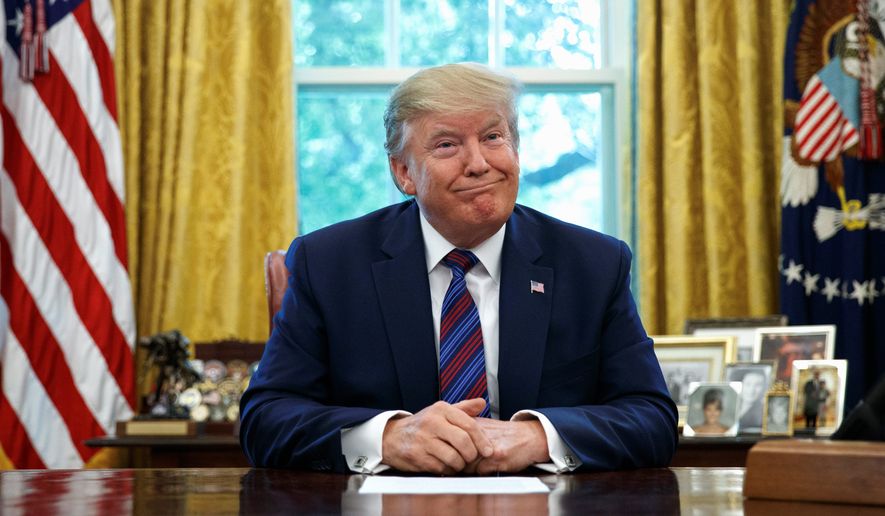President Trump is suddenly on a surprising winning streak when it comes to immigration.
With his border wall, where the Supreme Court has cleared the way to begin construction under his emergency declaration, and negotiations with Latin American neighbors, Mr. Trump in the past weeks has finally begun to make headway on a number of major items on his immigration checklist.
The court and foreign policy victories were coupled with some policy moves within the administration that could further constrain the surge of migrants, including guidance issued Friday telling asylum officers to make sure migrants are fleeing state-sanctioned violence before they are granted asylum.
“The Trump administration is trying to throw everything it can at this problem,” said Jessica Vaughan, policy studies director at the Center for Immigration Studies.
The big moves last week included an agreement signed with Guatemala that will allow the U.S. to send any asylum-seekers who cross that country’s territory en route to the U.S. back to Guatemala to ask for asylum there instead.
Given Guatemala’s strategic geographic location — it lies on Mexico’s southern border, and land travelers must cross it during their journey north — the agreement could allow the U.S. to deny tens of thousands of asylum-seekers the chance to ask for status before they reach the border.
“We’ve long been working with Guatemala, and now we can do it the right way,” Mr. Trump said in the Oval Office after signing the deal with Guatemalan Interior Minister Enrique Degenhart.
Hours later, the president received news of another win: The Supreme Court, in a 5-4 ruling, had cleared the way for him to use his emergency border declaration to use Pentagon money to build more of his wall.
The Republican-appointed justices ended a lower-court blockade of his budgeting moves, limits that a federal district judge in California and later an appeals court had imposed while the case was being argued on the merits.
The high court didn’t reveal its reasoning, but the ruling is a major victory at a crucial time.
Mr. Trump’s attorneys told the justices they were racing a Sept. 30 deadline. If they didn’t obligate the money by then, they would lose the chance to spend it on the wall.
The immediate effect of the ruling is to let the administration tap several billion dollars within the Pentagon’s budget and direct it toward building the wall, which was Mr. Trump’s most visible 2016 campaign promise.
Opponents said they will continue to fight, including pressing lower courts to speed up the arguments on their broader challenge to the emergency declaration’s constitutionality.
“This is not over,” said Dror Ladin, an attorney for the American Civil Liberties Union.
House Speaker Nancy Pelosi, California Democrat, said the Supreme Court ruling “undermines the Constitution.”
Mr. Trump expressed his enthusiasm in his unique system of uppercase letters on Twitter: “Big WIN for Border Security and the Rule of Law!”
The two victories for Mr. Trump last week follow on his success in June, when he used the threat of tariffs to force Mexico to the bargaining table. Mexico agreed to do more to head off migrants crossing its territory and to take back more Central American asylum-seekers, making them wait in Mexico while their cases proceed through the U.S. immigration courts.
The effects of the Mexico deal were already having some effect.
Acting Homeland Security Secretary Kevin McAleenan told “Fox Business Sunday” that the number of illegal immigrants nabbed at the U.S.-Mexico border fell 28% in June and is down another 20% in July.
In May, Customs and Border Protection encountered 4,650 unauthorized migrants a day. The number now is 2,600, he said.
The emergency border spending bill that Mr. Trump won from Congress a month ago has also helped ease overcrowding at border facilities.
At its peak in early June, CBP had 19,000 people in custody. That number is now 7,200, Mr. McAleenan said.
One of Mr. McAleenan’s top lieutenants took yet another step Friday to try to reduce the flow of migrants by ordering asylum officers to cast a dim eye on some asylum claims.
“Private violence” doesn’t cut it, said Ken Cuccinelli, acting director of U.S. Citizenship and Immigration Services. While conditions may be rough, he said, there just isn’t enough “pervasive” violence in El Salvador, Honduras and Guatemala to automatically grant asylum to people fleeing those countries.
Mr. Trump started winning immigration fights after he revamped his team, shuffling the leaders of the Homeland Security Department and each of the three agencies that handles immigration. The department and all three agencies are now headed by temporary officers.
The administration’s moves will continue to face scrutiny in the courts.
Several activist groups have vowed to challenge the Guatemala asylum agreement. Critics said that country isn’t safe enough nor capable enough to provide asylum to others crossing its territory.
“Such an arrangement would make a mockery of the notion that those fleeing persecution in Central America have any recourse,” said Eric Schwartz, president of Refugees International.
Ms. Vaughan, though, said the Guatemala agreement was proof that the U.S. does have leverage with foreign countries that previous administrations hadn’t used.
“What remains to be seen is which message comes through stronger in Central America (and around the world now) — do they hear that the risk of failure is much higher now because Trump and the other governments are cracking down, or do they hear that American judges are blocking his efforts?” she said.
She said the Trump administration must be prepared to fend off those legal challenges.
“Now that Trump has come to realize that Congress isn’t going to be much help, and that he needs to go at this problem from all angles, with every immigration agency involved, it looks like we are finally starting to see results,” she said.
• Stephen Dinan can be reached at sdinan@washingtontimes.com.




Please read our comment policy before commenting.